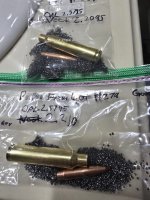I have watched those Hornady podcasts (ep 50 and 52) as well as the mean radius and the one-hole group more than once. I have seen ep 50 and 52 4 times. I learn something new each time. For example, a problem Myles alludes to is while a hunter such as I am, may get a good 3 shot group, I can do that 7 times, as Jayden says, to get a minimum 20 - ish shot grouping. But what if the center of mean radius has shifted each time?Generally speaking, yes. There are some exceptions where I don't think I've seen the "commercial" stuff vary any more than the cannister grade but most of what we get is more variable lot-to-lot. I think Jayden went into it on one of our podcast episodes but basically one of the big powder mfgs. we work with makes sizes of kernels and then has burn rate modifiers added. There's a prescription for the burn rate modifiers for certain families of powders but the moral of the story is that they make a bunch of "fast" and "slow" and mix them to match previous test data and if the end result falls within a narrow enough window that becomes "CFE 223" for example. Then everything that wasn't quite CFE223 falls inside a bigger window and that's what big ammo mfgs. get. Not many places are mixing at the ammo factory level but there is some secondary mixing that can be done if necessary if you have the right size/family of powders and most importantly, are able to pressure test what you've done.
That is, even if you choose the same refined PoA, such as top of the diamond on the lower left on an ST-1 target, might the center of mean radius be different each time, meaning that while you think your rifle is .61 MOA, it is actually 1.25 MOA. The only way to tell is to shoot 3 shot groups from a cold barrel 7 times. Either at the same target as before, or another one, which is more difficult because now you have to find a way to overlay.
As a hunter, I am really concerned about the first two shots. Cold bore needs to be on the head of the nail. Second one can be less than an inch. I doubt there will be a third shot.
Factory ammo is going to vary and I bet dollars to donuts that factory ammo from 6.5 CM varied, as well, but that did not stop guys from growing man-buns and getting a 6.5 CM.


